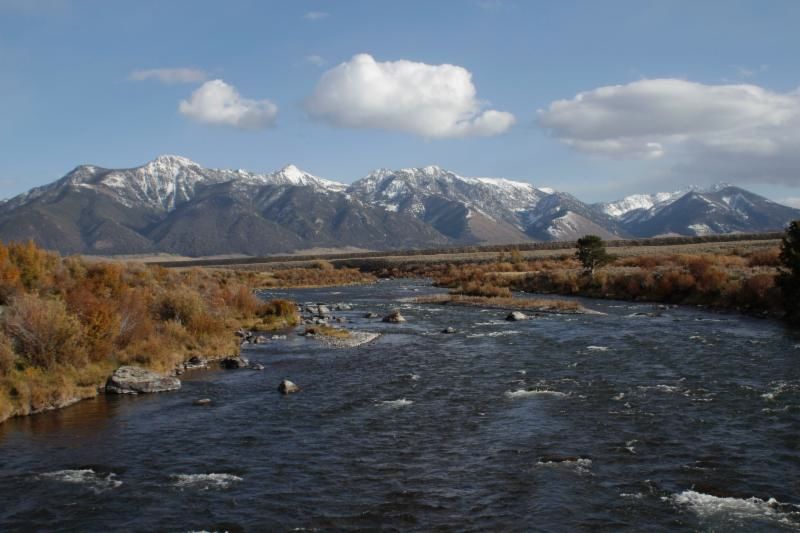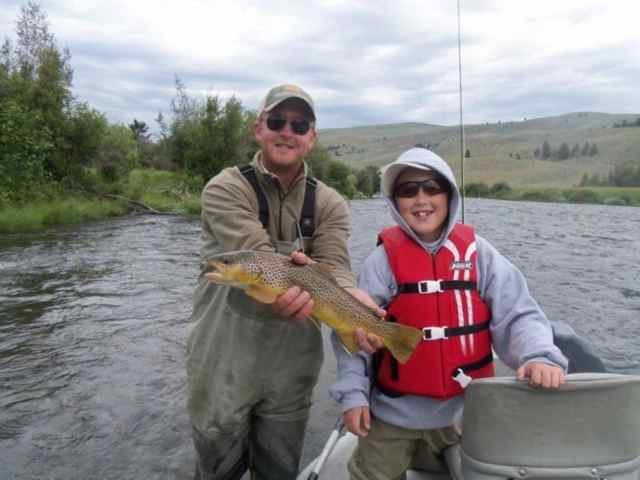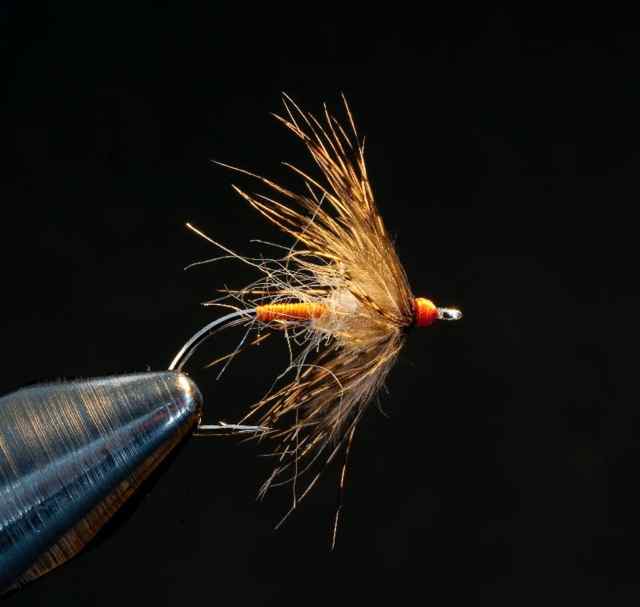Idaho Fish Report
What's Happening in Yellowstone Country

by Blue Ribbon Flies
10-10-2013
406-646-7642
Website
By: Craig Mathews
I've got my Tenakara rod and a fresh supply of BRF Soft Hackle Midge Emergers ready to fish today. I haven't fished in a couple days but after spending yesterday morning in the shop with all the reports of trout rising near Raynolds and $3 Bridge I made my mind up to put aside the other stuff I have to get done before the snow flies and hit the river at 9a.m. for midge action. I'll come home for lunch then back on the river by 1p.m. for Baetis action! Let's take a look what fall anglers can expect from both insects during their times on Yellowstone country's water in late season.
Several anglers have stopped in with reports of trout tailing and porpoising as they pick off midge pupae just before they reach the surface. One friend of mine even took out his insect sampling net and sampled the flow after an hour of watching fish in shallow water taking what turned out to be pupae, and not being able to fool one. He said he was so frazzled watching trout in 6 inches of water, and within 10 feet of him and not being able to fool one. He became frustrated and threw his rod onto the bank and spent the next hour on his hands and knees with his little net capturing nothing but midge pupae in the drift. Asked if he tried a midge he said he did not, he'd left his midge box in his truck. He said this went on from 9 to 11a.m. when the fish went down and he drove home to return after lunch for the 1-4p.m. Baetis hatch. I gave him a couple of our Soft Hackle Midge Emergers and he called last night and said he took some nice fish on this pattern where he'd been skunked the day before.
Mid-morning fishing can be great, with the right fly, in October and November when conditions are right. A calm-warm morning (30 degrees and higher) with cloud cover is best. The river below Quake Lake and downstream to Ennis can offer up some fine midge fishing for morning anglers willing to walk and stalk searching pools, slicks and pockets for tailing and porpoising fish on the pupae. This action can be repeated in late afternoon, after Baetis times, when midges become active again provided the winds lay down.
Midges are subject to many emergence defects, and cripples and stillborns are common. Big trout can be found feeding readily on such flies so we like to carry imitations with like or Soft Hackle or Zelon Midge. Both have trailing shucks; one using zelon and the other hackle fibers. These patterns are fished dry and since they can be seen they are easier to fish than subsurface pupal imitations. It is important to get close to fish rising to emerging midges to keep track of your fly and eliminate any drag. By carefully walking and stalking you will find several spots along the river trout are rising to midges. I am amazed every time I walk the bank just how many anglers I see storming along the shoreline with a huge bobber and nymph attached to their rods totally oblivious to trout rising nearly at their feet! They are missing some of the most challenging and rewarding angling opportunities the rivers offer this time of the year.
Madison Valley, Montana: A model for land & water conservation
The Madison River Valley in Montana is a rare jewel near Yellowstone National Park, and a model for land and water conservation efforts. It's a place that evokes wonder and amazement in those that enjoy it for recreation and its world renown for fly-fishing. It is also a critical wildlife corridor and watershed.
The valley is over 50% protected--that's 230 square miles--and it is one of the biggest conservation efforts in Montana. We are able to help protect places like this because of people like you.
Baetis generally emerge 1-4p.m. Weather always plays a role in determining the length and intensity of the hatch. Cool-wet weather is best. The duns emerge from their nymphal shucks at the surface where trout feed on nymphs and crippled duns in the surface film. When the emergence is heavy big trout concentrate on nymphs and stillborns, porpoising and tailing as they take the naturals in the film. I get close to the rising fish, approaching from downstream and often but a rod length away. This helps eliminate as many currents between me and the fish and it reduces drag and improves casting accuracy. Tenkara fishing is outstanding for this as I can usually keep my line off the water with only the tippet and fly to float to my target.
When a Baetis hatch becomes heavy, common for this mayfly on cool-overcast days, trout will lock into narrow feeding lanes. I like to use a floating fly like our Sparkle Dun or BRF Foam Emerger as it is easier to see if the cast is kept short. The emergence can be so heavy it is difficult for your fly to compete with the naturals. You can do everything right but not catch many fish simply due to the competition your fly faces. You can improve your chances by singling out one trout and concentrate on it. (Flock shooting is always tempting but usually fruitless!) It will help make short-accurate-fast presentations repeated quickly and increasing the chances your fly will be taken.
Daylight is creeping in here at our camp. It looks like a good start to a fishing day, overcast and 36 degrees. A Stellars Jay croaks its morning call for peanuts as it has the past few October mornings, and our dogs bark at the racket it makes until Jackie brings it breakfast. I maintain it is the same bird we've seen here for 3-4 years now. Where it goes for the summer months we can only guess but every October it shows up here and stays for the winter. Bright blue feathers, piercing yellow eyes and a shinny black beak it allows us to come within a fly rod length away to give it a couple nuts each morning. After, it flies up into the Douglas Fir Trees and boulder field north of our place and hangs out there for the day returning around 5p.m.for another snack. If will not let Jackie forget its treats; if she fails to come through with the peanuts it will make a racket until she delivers with the goods.
I've got my Tenakara rod and a fresh supply of BRF Soft Hackle Midge Emergers ready to fish today. I haven't fished in a couple days but after spending yesterday morning in the shop with all the reports of trout rising near Raynolds and $3 Bridge I made my mind up to put aside the other stuff I have to get done before the snow flies and hit the river at 9a.m. for midge action. I'll come home for lunch then back on the river by 1p.m. for Baetis action! Let's take a look what fall anglers can expect from both insects during their times on Yellowstone country's water in late season.
Several anglers have stopped in with reports of trout tailing and porpoising as they pick off midge pupae just before they reach the surface. One friend of mine even took out his insect sampling net and sampled the flow after an hour of watching fish in shallow water taking what turned out to be pupae, and not being able to fool one. He said he was so frazzled watching trout in 6 inches of water, and within 10 feet of him and not being able to fool one. He became frustrated and threw his rod onto the bank and spent the next hour on his hands and knees with his little net capturing nothing but midge pupae in the drift. Asked if he tried a midge he said he did not, he'd left his midge box in his truck. He said this went on from 9 to 11a.m. when the fish went down and he drove home to return after lunch for the 1-4p.m. Baetis hatch. I gave him a couple of our Soft Hackle Midge Emergers and he called last night and said he took some nice fish on this pattern where he'd been skunked the day before.
Mid-morning fishing can be great, with the right fly, in October and November when conditions are right. A calm-warm morning (30 degrees and higher) with cloud cover is best. The river below Quake Lake and downstream to Ennis can offer up some fine midge fishing for morning anglers willing to walk and stalk searching pools, slicks and pockets for tailing and porpoising fish on the pupae. This action can be repeated in late afternoon, after Baetis times, when midges become active again provided the winds lay down.
Midges are subject to many emergence defects, and cripples and stillborns are common. Big trout can be found feeding readily on such flies so we like to carry imitations with like or Soft Hackle or Zelon Midge. Both have trailing shucks; one using zelon and the other hackle fibers. These patterns are fished dry and since they can be seen they are easier to fish than subsurface pupal imitations. It is important to get close to fish rising to emerging midges to keep track of your fly and eliminate any drag. By carefully walking and stalking you will find several spots along the river trout are rising to midges. I am amazed every time I walk the bank just how many anglers I see storming along the shoreline with a huge bobber and nymph attached to their rods totally oblivious to trout rising nearly at their feet! They are missing some of the most challenging and rewarding angling opportunities the rivers offer this time of the year.
The valley is over 50% protected--that's 230 square miles--and it is one of the biggest conservation efforts in Montana. We are able to help protect places like this because of people like you.
Baetis generally emerge 1-4p.m. Weather always plays a role in determining the length and intensity of the hatch. Cool-wet weather is best. The duns emerge from their nymphal shucks at the surface where trout feed on nymphs and crippled duns in the surface film. When the emergence is heavy big trout concentrate on nymphs and stillborns, porpoising and tailing as they take the naturals in the film. I get close to the rising fish, approaching from downstream and often but a rod length away. This helps eliminate as many currents between me and the fish and it reduces drag and improves casting accuracy. Tenkara fishing is outstanding for this as I can usually keep my line off the water with only the tippet and fly to float to my target.
When a Baetis hatch becomes heavy, common for this mayfly on cool-overcast days, trout will lock into narrow feeding lanes. I like to use a floating fly like our Sparkle Dun or BRF Foam Emerger as it is easier to see if the cast is kept short. The emergence can be so heavy it is difficult for your fly to compete with the naturals. You can do everything right but not catch many fish simply due to the competition your fly faces. You can improve your chances by singling out one trout and concentrate on it. (Flock shooting is always tempting but usually fruitless!) It will help make short-accurate-fast presentations repeated quickly and increasing the chances your fly will be taken.
Daylight is creeping in here at our camp. It looks like a good start to a fishing day, overcast and 36 degrees. A Stellars Jay croaks its morning call for peanuts as it has the past few October mornings, and our dogs bark at the racket it makes until Jackie brings it breakfast. I maintain it is the same bird we've seen here for 3-4 years now. Where it goes for the summer months we can only guess but every October it shows up here and stays for the winter. Bright blue feathers, piercing yellow eyes and a shinny black beak it allows us to come within a fly rod length away to give it a couple nuts each morning. After, it flies up into the Douglas Fir Trees and boulder field north of our place and hangs out there for the day returning around 5p.m.for another snack. If will not let Jackie forget its treats; if she fails to come through with the peanuts it will make a racket until she delivers with the goods.


